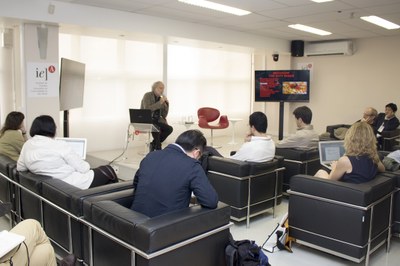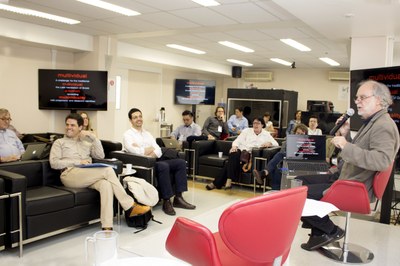Kairos encounters Chronos. The ubiquity of ethnography for achieving spacetimes in digital cultures

The last talk of the first phase of the Intercontinental Academia was special to reflect about the multiplicity of topics that were treated in the previous expositions and, as Jorge Luis Borges says, the “ubiquitous problem of time”. An appassionato Italian anthropologist, Massimo Canevacci brought to us a strong dissertation entitled “The ethnographic experiences of digital cultures and the syncretic mix of spacetimes”.
'Ubiquitimes' was introduced as a core concept of an anthropological methodology to understand the transformation that digital cultures are making with respect to the linear notion of space-time. Internet’s space-time can be conceived nowadays as the emergence of ubiquit times and spaces, interconnected in multiple levels of imagination, meanings and experiences.
In convergence with the mythological metaphors remarked in many previous talks, Canevacci mentioned that besides Chronos, Greek people had another divinity for time called Kairos, referred to the displacement of events, an indeterminate and spontaneous time. In dissonance with the metric, rationalist and linear time that Chronos manifests, Kairos expresses a substantial mode to apprehend the virtual and digital syncretism that characterizes contemporary life.
Ubiquitimes are composed by three central concepts or statements: simultaneity, chronotope and ubiquity. In the first one, the synchronic link between subjectivity, aesthetic and political ideas is condensed; all of them come together and conform the landscape where it is possible to experience simultaneity. The second one expresses the unification of space and time in a narrative proposed by Mikail Bachtin, who pointed out the end of the monological projection of the author by decentering this in the construction of the narrative. Gregory Bateson and Margaret Mead are examples of this methodological implementation in anthropology writings. The last one is rooted in the traditional idea of the panoptic view of God in Christian religion, the mystically idea that everything could be seen, known and judged in every place at any moment.
Applied to digital cultures, ubiquity embodies the relation that people have with digital technology and Internet, mixing logical and sensorial experiences in many senses. This allows to capture the connection between the material and the inmaterial, to go beyond the dualistic form of thinking. Ubiquity refers, Canevacci emphasized, to the potential imagination connected to the rising of techno-digital.
As an example, he presented a street manifestation in Barcelona, virtually practiced through holograms to protest against a public policy without affecting the transit. This ubiquitous way of manifesting social changes creates a new manner to do politics, based on digital supports and in the multiple individualities or multividual identities. Another example mentioned to compare the enormous distance between the notion of time in industrialization and the ubiquitimes was the excellent movie series “Black Mirror”, the contents of which predict the near future of techno-virtual society, anticipating in many things the scientific analysis of prospective social and global scenarios.
 In the same direction, Bottega digitale (with no direct translation to English), a kind of digital source where it is possible to experience art, exemplified the richness of connecting art with science, taking a renascent concept of a creative solid environment to comprehend digital and virtual cultures. Also, concerning the mutation in space ideas, he compared “utopia”, which means no place, with "ubiquity", which means all places. Taking the works of architect Zaha Hadid, who materializes ubiquity through design and style of her architecture, an innovative way to spatially express the symptoms of societiesit was shown to us.
In the same direction, Bottega digitale (with no direct translation to English), a kind of digital source where it is possible to experience art, exemplified the richness of connecting art with science, taking a renascent concept of a creative solid environment to comprehend digital and virtual cultures. Also, concerning the mutation in space ideas, he compared “utopia”, which means no place, with "ubiquity", which means all places. Taking the works of architect Zaha Hadid, who materializes ubiquity through design and style of her architecture, an innovative way to spatially express the symptoms of societiesit was shown to us.
The Italian anthropologist proposes to think about the social mutations that globalization is making to emerge in every nook of the globe. He showed us an ethnographic example of his fieldwork with Bororo people in the Amazonas – the same village where Lévi-Strauss stayed in 1935 - who are creating their own films with digital video cameras and use Facebook as any other society with Internet connection. In another opportunity, surprised that his Xavante informant was filming at him, he asked to himself “Who is the anthropologist? Who has the right to represent a different culture?” The answer, confessed Cannevaci, take us to the problem of the self-representation.
Through all these ethnographic cases, it has been demonstrated how experiences of ubiquitous notions of time in different cultures and persons are auto-generated. Precisely, when introducing Karl Heinz Kohl's talk “Concepts of time across the cultures: an anthropological view presentation”, Canevacci mentioned that ethnography is not an exclusive tool for anthropology anymore and emphasized that nowadays it belongs to the humanities as a whole field of human concerns, which includes art and science of course.
Through a cross-language performance between English, Portuguese and Italian, he showed the deployment of the force that multiculturalism has to offer for the challenge of conceiving an intercontinental approach of art and science – as Jacopo de Barbari’s painting “Portrait of Luca Pacioli”, Nele Azevedo’s temporary art “Minimum Monument”, György Ligeti’s “Poem Symphony” or the Bororo’s video of self-representation remind us.
